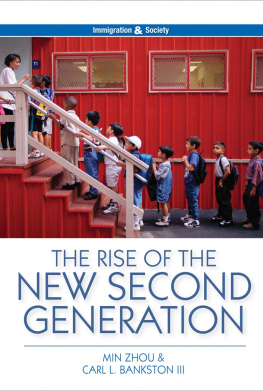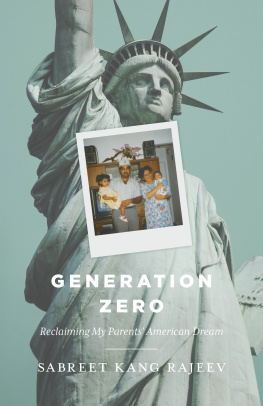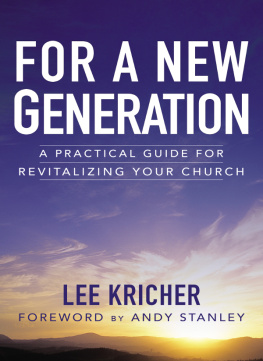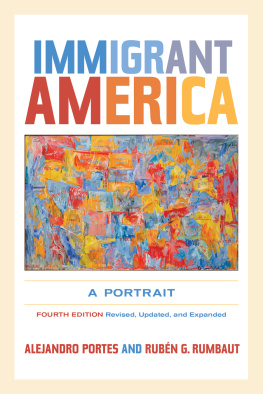Contents
Guide
Pages

Immigration & Society series
Carl L. Bankston III, Immigrant Networks and Social Capital
Stephanie A. Bohon & Meghan Conley, Immigration and Population
Thomas Faist, Margit Fauser, & Eveline Reisenauer, Transnational Migration
Christian Joppke, Citizenship and Immigration
Grace Kao, Elizabeth Vaquera, & Kimberly Goyette, Education and Immigration
Nazli Kibria, Cara Bowman, & Megan OLeary, Race and Immigration
Peter Kivisto, Religion and Immigration
Cecilia Menjvar, Leisy J. Abrego, & Leah C. Schmalzbauer, Immigrant Families
Ronald L. Mize & Grace Pea Delgado, Latino Immigrants in the United States
Philip Q. Yang, Asian Immigration to the United States
Min Zhou & Carl L. Bankston III, The Rise of the New Second Generation
The Rise of the New Second Generation
Min Zhou and Carl L. Bankston III
polity
Copyright Min Zhou and Carl L. Bankston III 2016
The right of Min Zhou and Carl L. Bankston III to be identified as Author of this Work has been asserted in accordance with the UK Copyright, Designs and Patents Act 1988.
First published in 2016 by Polity Press
Polity Press
65 Bridge Street
Cambridge CB2 1UR, UK
Polity Press
350 Main Street
Malden, MA 02148, USA
All rights reserved. Except for the quotation of short passages for the purpose of criticism and review, no part of this publication may be reproduced, stored in a retrieval system, or transmitted, in any form or by any means, electronic, mechanical, photocopying, recording or otherwise, without the prior permission of the publisher.
ISBN-13: 978-0-7456-8472-7
A catalogue record for this book is available from the British Library.
Library of Congress Cataloging-in-Publication Data
Zhou, Min, 1956
The rise of the new second generation / Min Zhou, Carl L. Bankston III.
pages cm -- (Immigration and society)
Includes bibliographical references and index.
ISBN 978-0-7456-8468-0 (hardcover : alk. paper) -- ISBN 0-7456-8468-8 (hardcover : alk. paper) -- ISBN 978-0-7456-8469-7 (pbk. : alk. paper) -- ISBN 0-7456-8469-6 (pbk. : alk. paper) 1. Children of immigrants--United States--History. 2. United States--Emigration and immigration--Social aspects. 3. United States--Emigration and immigration--Government policy--History. I. Title.
E184.A1.Z48 2016
325.73--dc23
2015030145
The publisher has used its best endeavours to ensure that the URLs for external websites referred to in this book are correct and active at the time of going to press. However, the publisher has no responsibility for the websites and can make no guarantee that a site will remain live or that the content is or will remain appropriate.
Every effort has been made to trace all copyright holders, but if any have been inadvertently overlooked the publisher will be pleased to include any necessary credits in any subsequent reprint or edition.
For further information on Polity, visit our website: politybooks.com
For the children of contemporary immigrants:
Philip Jia Guo and Lisa Phuong Mai Tala Marikit Bankston, Andrew Bankston, and Leon Victor Bankston
Acknowledgments
Many people have helped us directly and indirectly in writing this book. Among them, we would like to thank first and foremost Jonathan Skerrett, sociology editor of Polity Press, for his initiation of the project and his advice, encouragement, and patience throughout the process. We would also like thank Polity production editor India Darsley and copy-editor Gail Ferguson for their meticulous work in bringing this manuscript into print. We would also like to thank the anonymous readers for their insightful criticisms, suggestions, and recommendations on our proposal and full manuscript. We are indebted to Jennifer Lee, Anthony Ocampo, Alejandro Portes, and many other colleagues for their thoughts and comments. This book would not have been written without the support of our institutions, Nanyang Technological University, University of California, Los Angeles, and Tulane University, as well as partial funding from the Walter & Shirley Wang Endowed Chair in USChina Relations and Communications. Our own children Philip and Lisa (Mins) and Marikit, Andrew, and Victor (Carls) are the children of immigrant parentage, who have given us invaluable insight into new second-generation lives. We are grateful to our spouses Mins husband Sam Guo and Carls wife Cynthia Bankston who have offered unconditional love and unfailing support for us. Finally, we would like to thank the members of the new second generation whom we have studied in the field of international migration and taught in our classrooms.
Introduction: The New Second Generation Coming of Age
A rapidly globalizing economy, ever-improving means of transportation and information and communications technology (ICT), and increasingly intertwined social networks have enabled unprecedented movements of people around the world, creating highly visible concentrations of new immigrant populations in traditional or new destinations and stimulating constant transnational flows. By the count of the United Nations Department of Economic and Social Affairs, 232 million people, or 3.2 percent of the worlds population, were international migrants in 2013, compared with 154 million in 1990. The United States takes the lions share, hosting the largest number of international migrants at 45.8 million (UNDESA, 2013). Consequently, more and more children in our world are growing up in immigrant or transnational households. In the United States, children of immigrants account for nearly the entire growth in the US child population in the 1990s and 2000s (Fortuny, Hernandez, and Chaudry 2010). One child in five is a child of immigrants (Hernandez and Cervantes, 2011; Surez-Orozco, Surez-Orozco, and Todorova, 2008). Like their immigrant parents, these children are highly diverse in origins and socioeconomic backgrounds. Their economic situations, educational attainment, and health will shape their own futures while significantly influencing the futures of their host countries. In addition, new social media have impacted the lives of children in unprecedented ways, making them active participants in a global popular culture that is constantly evolving as people move faster and farther physically and virtually.
In this book, we focus on the new second generation in the nation-state that takes the lions share of international migrants (20 percent) in the world the United States (UNDESA, 2013). We refer to the new second generation as the native-born or US-raised children with foreign-born parents who have arrived in the United States after the passage of the Immigration and Nationality Act of 1965 (also known as the HartCeller Act). We describe and analyze the new second generation in this major migrant-receiving country and consider both country-specific and general implications of large-scale international migration for the children of immigrants coming of age in the twenty-first century.
The old and new second generation
In describing the children of immigrants as members of a new second generation, we make an implicit comparison to an old second generation growing up in the first half of the twentieth century. What was this old second generation? Does existing knowledge about the old second generation continue to be relevant for understanding the new second generation? How do the children of contemporary, or post-1965, immigrants differ from their predecessors? Do members of the new second generation follow the same pathways taken by the old second generation? What do these differences mean for the study of the new second generation? These are some of the primary questions we address at the outset of this book in order to situate the new second generation in American historical and comparative contexts. By placing the children of contemporary immigrants within their historical setting and identifying the different circumstances and experiences of the old and new second generations, we systematically interrogate established theories and alternative models about immigrant assimilation, integration, or incorporation.









